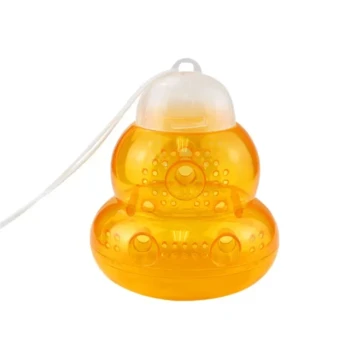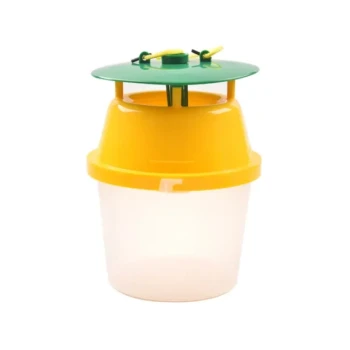Without question, one of the most destructive pests a beekeeper will face is the small hive beetle, Aethina tumida. Originally from sub-Saharan Africa, this opportunistic scavenger has spread globally, and its presence can lead to the rapid collapse of a honey bee colony if left unchecked. The beetle's true danger lies not in the adults, but in their larvae, which can quickly overwhelm a hive.
The core threat of the small hive beetle is not just predation, but contamination. Its larvae tunnel through comb, consuming brood, pollen, and honey, while introducing a yeast that ferments the honey, creating a foul-smelling slime that drives the bees to abscond.

Understanding the Beetle's Impact
The small hive beetle (SHB) is a threat multiplier. It excels at exploiting colonies that are already under stress from other factors, such as weakness from varroa mites, a failing queen, or a small population size.
Identifying the Intruder
Adult beetles are small (about 1/4 inch long), dark brown or black, and oval-shaped. They are fast-moving and tend to hide in dark cracks and crevices within the hive, often fleeing from light when a beekeeper opens the colony for inspection.
The larvae are the primary cause of damage. They are cream-colored, maggot-like creatures that can be confused with wax moth larvae. However, SHB larvae have three pairs of prolegs near the head and prominent spines along their back, whereas wax moth larvae are smoother and have prolegs along their entire body.
The Lifecycle of Destruction
Adult female beetles enter a hive and lay their eggs in clusters, often hidden in cracks or directly in cells of pollen or brood. Once hatched, the larvae begin a voracious feeding cycle.
They tunnel through the comb, consuming whatever is in their path: bee eggs, larvae, pollen stores, and honey. As they feed on honey, they defecate, introducing a specific yeast (Kodamaea ohmeri) into the stores.
This yeast rapidly ferments the honey, causing it to bubble, change color, and run out of the cells. The result is a characteristic slimy, foul-smelling mess that gives a severe infestation its name: a "slime-out." This contaminated environment is repellent to the bees, often forcing them to abandon the hive entirely.
Understanding the Trade-offs: Hive Strength vs. Beetle Pressure
Not every hive with beetles is doomed. A colony's ability to defend itself is the single most important factor in determining the outcome of a beetle encounter.
The Power of a Strong Colony
A populous, healthy hive is the best defense. Worker bees will actively pursue and harass adult beetles. They are often successful at corralling them into small sections of the hive, creating "beetle jails" where the beetles are imprisoned and unable to lay eggs.
The Vulnerability of Weak Hives
Weak colonies, such as newly started nucleus hives ("nucs"), recent splits, or those suffering from disease, lack the bee population required to effectively police the beetles. In these hives, a small number of egg-laying beetles can quickly lead to a catastrophic larval infestation.
Environmental Factors
The small hive beetle thrives in warm, humid climates. The larvae, when mature, exit the hive and pupate in the soil nearby. Sandy or loose soil makes this process easier, leading to a higher rate of successful pupation and a greater number of new adult beetles emerging to re-infest the same or neighboring hives.
Making the Right Choice for Your Apiary
Your strategy for managing small hive beetles must be tailored to the strength of your colonies and your specific goals.
- If your primary focus is prevention in strong hives: Maintain colony health, avoid giving bees more space than they can patrol, and use simple in-hive mechanical traps (like oil-filled trays) to reduce the adult beetle population.
- If your primary focus is protecting a weak or new colony: Keep the hive entrance reduced and the interior space compact. Be extremely vigilant during inspections and install traps immediately upon finding any adult beetles.
- If your primary focus is dealing with an active infestation: If you see larvae and slime, act decisively. Freeze infested frames for 48 hours to kill all beetle life stages (eggs, larvae, adults) and transfer the bees to clean equipment. The slimed honey is unsalvageable.
Ultimately, proactive management and maintaining strong, healthy colonies are your most powerful defenses against this destructive pest.
Summary Table:
| Pest | Key Threat | Primary Damage | Defense Strategy |
|---|---|---|---|
| Small Hive Beetle | Larval "slime-out" from fermentation | Comb destruction, honey contamination, colony absconding | Maintain strong hives, use in-hive traps, freeze infested frames |
Protect your apiary's productivity and profitability.
A small hive beetle infestation can lead to significant financial losses from colony collapse and contaminated honey. HONESTBEE supplies commercial apiaries and beekeeping equipment distributors with the wholesale-focused tools and equipment needed for effective pest management, including durable hive components and beetle control solutions.
Let our expertise strengthen your defense. Contact our team today to discuss wholesale solutions tailored to your operation's scale and challenges.
Visual Guide

Related Products
- Reusable Clear Small Hive Beetle Traps for Beehives Beetle Trapping Tools
- Black Plastic Beetle Barn Hive Beetle Trap for Beehives
- Reusable Aluminium Beetle Trap for Small Hive Beetles Silver Bullet
- Removable Washable Hive Beetle Trap Attractants for Small Hive Beetles
- Plastic Beetle Blaster Trap Beekeeping Tools and Supplies
People Also Ask
- What are small hive beetles and where are they not indigenous? Protect Your Apiary from This Invasive Pest
- How do Beetle Blasters trap adult beetles? A Simple, Non-Chemical Pest Control Solution
- Why are hive beetle traps important for beekeepers? Protect Your Hive from a Devastating Infestation
- What are the steps for installing hive beetle traps? A Guide to Effective Beetle Control
- How should filled beetle traps be handled? Safely Remove and Dispose to Protect Your Hive



















